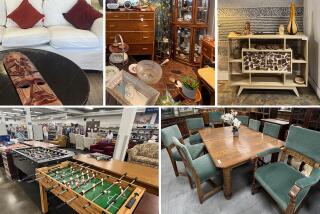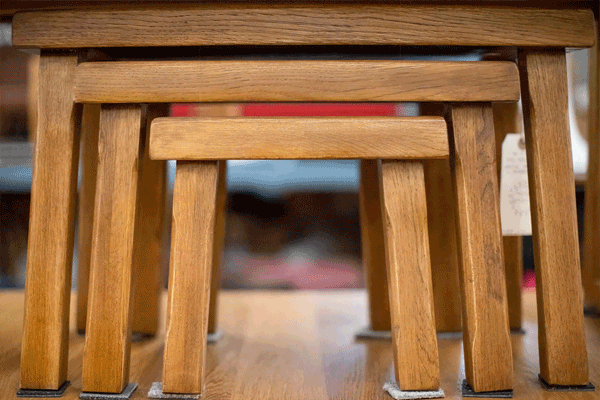Fashioning Fresh Looks for the Wood Bored
OTTERBEIN, Md. — It’s old; it’s new, and it’s environmentally conservative.
Antique-style armoires, breakfronts, tables, beds and cabinets, newly made of salvaged old wood, are proving a popular addition to the regular line of fine and homey old furnishings at stores such as Gaines-McHale Antiques.
“We are primarily antiques,” says Jean McHale, “but it happens every day in this business. People will come in and say, ‘For this particular kitchen, I’ve got to have a dresser that’s this wide, this tall, and it has to have a place to put my milkshake machine’ . . . But you could look for six years and not find that exact piece.”
A few years ago on one of her frequent buying trips to France and the British Isles, McHale discovered that salvagers in England have been assiduously saving old wood, mostly pine, from floors, doors and panels in houses and buildings slated for demolition, and using it to construct new pieces in old styles.
Now, McHale simply sits with clients and designs something to fit their needs.
“Old wood, new construction” is what McHale and her partner and husband, Michael, call these pieces, some of which are built in their shops behind their 32,000-square-foot showroom-storehouse, and some of which are built abroad.
Few old trees are being cut for lumber, and old wood is simply better for furniture, McHale says. “New wood just isn’t the same. They’re force-feeding trees; the trees have wider pores,” and you don’t get the tight grains.
“The Brits have been doing this for decades--and not telling you what they’re doing,” McHale says. The practice can make it hard even for savvy dealers to distinguish old-new pieces from antiques. At Gaines-McHale, such pieces are clearly marked, so there’s no confusion. Because most of the pieces are custom-made, clients know what they’re getting.
While other importers do armoire conversions and stripping/finishing, few shops in the country put as much emphasis on newly constructed pieces.
“I see a lot of value in doing old wood, new construction, for a couple of reasons,” McHale says. “I think the recycling aspect is really good. They’re tearing down old buildings--are they going to burn [the wood]?
“Aesthetically, it makes a prettier piece of furniture. The woods that [are] extinct are in those pieces of furniture. You’re just recycling it into a new form that maybe will fit what you need better than what it came from.”
While many of the pieces feature a waxed natural finish, there is increasing demand for pieces in old-fashioned “milk” paint. The paint, in rich country colors of slate blue, Lexington green, yellow, barn red and white, has a matte finish that is “rubbed back” with sandpaper after it’s applied. A light rub-back will allow a hint of the grain to show through; a heavy rub-back makes the piece look older and may show some of the wood.
Although they are hardly cheap, such pieces are less expensive than comparable antiques, McHale says, with most about the same as a good reproduction. They can cost as little as a few hundred dollars; the price depends on how intricate the piece is.
“I have a problem with taking a good old piece and chopping it up,” McHale says. “I feel like there’s integrity in maintaining what was there.”
But sometimes clients insist on using an old armoire as an entertainment center.
When they’re asked to modify old pieces, Gaines-McHale will make only the smallest and most reversible of changes--taking out shelves and saving them, unscrewing the backing to push through an electrical cord, rather than making a hole.
“I have no problem taking a good old piece, such as the armoire over there, and building insides into it. In many cases, we’ll build the interior inside of an old piece, and we won’t even put a screw in it. In 10 minutes, you can take it back to what it was originally.”
However, some old furniture was bad to begin with or has been so altered or damaged throughout the years that its integrity has disappeared.
“Just because it’s old doesn’t make it right; just because it’s new doesn’t make it bad,” she says. “There’s good and there’s bad in every period, in every style.”
Figuring out how to salvage old bits and pieces is like solving a puzzle, McHale says. Her approach has evolved during the past decade, since she began buying old armoires and converting them to entertainment centers.
“It’s like in an art class, people will put [an object] there and say, ‘What can you use it for?’ . . . Sometimes, I look at a piece of furniture, and it just talks to me.”
She has used backs from salvaged sideboards as bed headboards, leaky urns as lamps, wooden games as table tops.
It’s all part of the recycling process, of making sure that the past doesn’t entirely disappear.
“We don’t waste anything,” she says.


